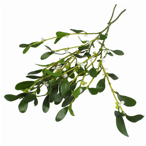Mistletoe (Viscum album)
Mistletoe is a plant that grows on trees such as apple, pine, oak, and elm. It is also called iscidor, helixor, and isorel. Scientifically, it is known as viscum album. It is a semiparasitic plant because it can take in nutrients from its host plant.
There are many types of mistletoe. The most well-known is the Western European version, which has rounded, emerald leaves and white berry clusters with 2 – 6 berries on them. The Eastern European version can have as many as 10 berries and shorter, broader leaves.
Historical Uses
Mistletoe was used as a cure for poisons and to treat barrenness (not being able to have a baby) and constipation. It has cultural meaning, as some Cornish customs made replicas of the cross out of mistletoe. There is also the act of kissing someone if you are both "under the mistletoe.”
Current Uses
Mistletoe is a form of medicine in European countries that is used to treat cancer. Weaknesses in research studies have prevented mistletoe from being used in the U.S. Researchers believe it fights cancer by stopping the creation of blood vessels that help cancerous tumors grow. Mistletoe extract has been shown to kill cancer cells in test animals and to boost the immune system by adding to the number of white blood cells. It has also been shown to lower the side effects of chemotherapy and radiation therapy and help quality of life. There have been many studies looking at these uses.
What are the active compounds in mistletoe extract?
Researchers believe viscotoxins, polysaccharide, and lectins are the active parts in mistletoe extract.
Parts Used and Preparations Available
Mistletoe extracts depend on things like:
- The kind of mistletoe plant used.
- How it is prepared.
- The time of year it is grown and harvested.
Mistletoe extracts are on hand in many parts of Europe and are most often given by injection under the skin. Sometimes they are given into a vein, pleural cavity (space between the lungs), or directly into a tumor. The U.S. Food and Drug Administration (FDA) has not approved the use of mistletoe for any medical purpose in the U.S. that is not research.
Side Effects and Safety Concerns of Herbal & Nutritional Supplements
Side effects differ based on the type of mistletoe used. Raw mistletoe leaves, branches, and berries are poisonous and should not be eaten. Mistletoe can cause stomach pain, diarrhea, low heart rate, seizures, and even death.
Purified mistletoe, which is made for injection, is a safer form of mistletoe. Side effects are inflammation at the injection site, headache, fever, and chills, though these are not very common. Side effects of purified mistletoe tend to be minor and not serious enough to cause concern. In rare cases, a person could be allergic and have a reaction that can cause trouble breathing, rash, redness, and low blood pressure.
You should talk to your provider about any questions you have about mistletoe.
References
Charalampidis C, Youroukou A, Lazaridis G, Baka S, Mpoukovinas I, Karavasilis V, Kioumis I, Pitsiou G, Papaiwannou A, Karavergou A, Tsakiridis K, Katsikogiannis N, Sarika E, Kapanidis K, Sakkas L, Korantzis I, Lampaki S, Zarogoulidis K, Zarogoulidis P. Pleura space anatomy. J Thorac Dis. 2015 Feb;7(Suppl 1):S27-32. doi: 10.3978/j.issn.2072-1439.2015.01.48. PMID: 25774304; PMCID: PMC4332049.
Mistletoe extracts(2023). National Cancer Institute..
Mistletoe from the National Center for Complementary and Alternative Medicine (NCCAM). 2020.
Grossarth-Maticek, R., Kiene, H., Baumgartner, S. M., & Ziegler, R. (2001). Use of Iscador, an extract of European mistletoe (Viscum album), in cancer treatment: prospective nonrandomized and randomized matched-pair studies nested within a cohort study. Alternative therapies in health and medicine, 7(3), 57.
Kienle, G. S., & Kiene, H. (2010). Review article: Influence of Viscum album L (European mistletoe) extracts on quality of life in cancer patients: a systematic review of controlled clinical studies. Integrative Cancer Therapies, 9(2), 142-157.
Kleijnen, J., & Knipschild, P. (1994). Mistletoe treatment for cancer review of controlled trials in humans. Phytomedicine, 1(3), 255-260.
Ostermann, T., Raak, C., & Büssing, A. (2009). Survival of cancer patients treated with mistletoe extract (Iscador): a systematic literature review. BMC cancer, 9(1), 451.
